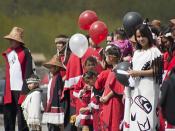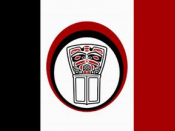The Nisga'a Treaty: A Template for the Future
The Nisga'a people have a long history of negotiations with British Columbia's Provincial Government. Over the past couple of years the Canadian Media has picked up the Nisga'a story. Their extensive coverage has both informed the public of the facts surrounding the Treaty and brought up many important issues surrounding those facts. Although, historically, compromise was not reached between the Nisga'a and the governing powers, recently the Treaty that finalized their negotiations was implemented. The process has brought up issues that have the media and public searching for facts about the future of treaty negotiations. For nearly 115 years, the Nisga'a People negotiated and compromised with the Federal and Provincial governments in an attempt to forge a settlement for the dispute surrounding aboriginal title.
According to Tony Hall (1996:5), a teacher in the Department of Native American Studies at the University of Lethbridge, "no Indian group in B.C.
has been more persistent than the Nisga'a of the Nass River Valley in defending and asserting their Aboriginal rights to their ancestral lands". Though the fifty or so other First Nations Bands are in the beginnings of the treaty process, only the Nisga'a have come to an agreement with the government. The Nisga'a Treaty is the first modern day treaty in British Columbia (Muckle 1998).
In 1887, Nisga'a chiefs travelled to Victoria to demand recognition of title, negotiation of treaties and provision for self-government, but they were turned away ("Nisga'a Treaty" 2000). Three years later, the Nisga'a established their first Land Committee to begin the campaign for recognition of territorial rights. It took until 1913 for the Nisga'a to send a petition to British Privy Council seeking to resolve the land question ("Nisga'a Treaty" 2000) and in 1927 the Canadian Parliament held...


